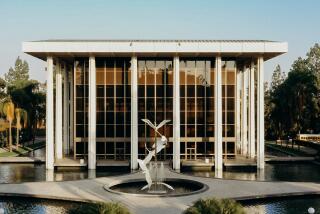Critic’s Pick: Disney and Segerstrom firing up their organs this weekend
Southern California has a spectacular, if quirky, standing in the organ world. First Congregational Church of Los Angeles on Wilshire boasts the biggest organ in the world, with more than 20,000 pipes. The Crystal Cathedral in Garden Grove has one of the most colorful, designed by Virgil Fox, and now undergoing renovation. Balboa Park in San Diego is home to the world’s largest outdoor organ.
But until Walt Disney Concert Hall opened in 2003, we were poor in concert hall organs. Royce Hall was long the most notable, and it went through considerable trouble to hide the pipes. So little liked, in fact, were concert hall organs in the latter part of last century that even Alice Tully Hall, which has Lincoln Center’s only organ, hid its pipes as well.
By making the Disney Hall organ a centerpiece of Disney’ interior design, Frank Gehry changed everything. If ever there was an organ demanding to be heard, it was Disney’s, which happens to sound glorious in the hall’s lively acoustics. No doubt the prominence of the Disney organ helped make it possible for the Segerstrom Center for the Arts to raise money for a striking organ in its Renée and Henry Segerstrom Concert Hall in Costa Mesa, which opened in 2006.
This weekend happens to be one in which both halls are featuring major works for organ and orchestra. It’s the 10th anniversary of the Disney organ (it wasn’t until a year after the hall opened that the instrument was fully tuned), and the first of several celebratory events will be Esa-Pekka Salonen conducting the U.S. premiere of Kaija Saariaho’s “Maan Varjot” (Earth’s Shadow).
The Finnish title for the three-movement score, which includes a large and colorful percussion section, comes from Shelly’s line “Heaven’s light forever shines, Earth’s shadows fly” in his “Adonais: An Elegy to the Death of John Keats.” The soloist is Olivier Latry, the organist of the Cathedral of Notre Dame in Paris.
Over at Segerstrom, the big organ piece is Maurice Duruflé’s Requiem, with Carl St.Clair conducting the Pacific Symphony and soloist Paul Jacobs. There is a Notre Dame connection here as well, since in 1927 Duruflé was appointed assistant of the cathedral’s then organist, composer Louis Vierne.
There is also something slightly shadowy about Durflé’s Gregorian chant-inspired Requiem. It was seemingly commissioned during World War II by the Vichy government. The premiere wasn’t until 1947, and whether Duruflé was a collaborator (which he denied) has never been satisfactorily answered. Still this is a Requiem of such haunting beauty that it has managed to transcend, or at least evade, politics.
Next month organ aficianados will have a chance for a direct comparison of the Disney and Segerstrom beheamoths, when the L.A. Phil pairs organ symphonies by Stephen Hartke (the premiere of his Symphony No. 4) and Saint-Saëns. The program, with Cameron Carpenter as soloist and Gustavo Dudamel conducting, will be given in both halls.
More to Read
The biggest entertainment stories
Get our big stories about Hollywood, film, television, music, arts, culture and more right in your inbox as soon as they publish.
You may occasionally receive promotional content from the Los Angeles Times.











